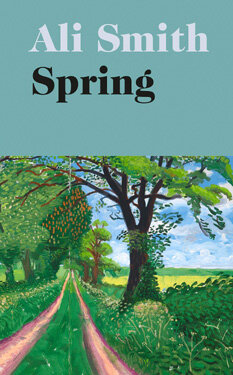The more I read of Ali Smith’s seasonal quartet, the more poignant and meaningful this magnificent artistic project feels. Although each novel has a self-contained story concerning a group of characters, an overarching fictional family is being built with small references connecting characters between the novels. This adds a little frisson of pleasure for attentive readers who spot the connections (one such link is explicitly made to “Autumn” at the end of this novel.) But, most of all, a portrait of our time period is being exquisitely encapsulated in Smith’s yearly novel account of recent events, society’s wildly divergent opinions and current political debates. The author also prompts us to ask important questions about the way we live now – one tenacious character in this novel continues to ask questions that need to be asked even when no answers are forthcoming. Moreover, Smith emphasises the importance of dialogue to better understand each other’s positions.
“Spring” primarily focuses on the story of Richard Lease, a down on his luck filmmaker mourning the loss of his good friend and former colleague/lover Patricia (Paddy). He contemplates a film project that playfully imagines a fictional relationship between the writers Katherine Mansfield and Rainer Maria Rilke. When his life comes to a crisis point he encounters a group of people he embarks on a journey with that includes Brittany (Brit), a correction officer at an immigration centre/prison; Florence, a mysterious girl who can freely enter forbidden spaces; and Alda Lyons, a librarian involved in a secret operation to assist detained immigrants. They engage in a number of conversations and relate stories to each other. Even when these characters try to avoid revealing themselves or step away from the stories of their lives they find themselves in a new story: “He was a man on a railway platform. There was no story. Except, there is. There always fucking is.” Smith reminds us that we’re always part of a larger narrative no matter how isolated we feel.
One of the fun tricks in this novel is that there are several short self-contained sections written in a collective or distinct narrative voice - in the way past books in the seasonal quartet have also done. These playfully mimic the voice of social media or represent an explosion of arguments. It’s revealed at one point that these are story sketches in Florence’s notebook making her a chronicler of our times in her own way. This is similar to the other characters in Smith’s previous books such as Elisabeth or Lux who are led by a bold curiosity and a wish to capture the spirit of an era through creative means. In addition to her fictional creations and as she’s done the previous novels, Smith also invokes the personality and artwork of a real female artist. In this novel she describes the artwork of Tacita Dean who tries to capture a cloud. It’s moving how Smith shows in these examples how there is a continuous artistic dialogue that runs alongside and intermingles with broader social and political dialogues taking place in our society.
‘Veteran Cloud’ by Tacita Dean
One of my favourite books by Smith is her novel “Artful” where she so beautifully depicts a character’s grief while contemplating a number of subjects. The way she wrote the character of Richard in this novel when his life grinds to a halt amidst the loss of Paddy made me recall how powerfully Smith depicts someone who experiences immense loss. She also touchingly describes his feelings of estrangement from his daughter who he hasn’t seen since she was young. He’s come to form frequent conversations with an imagined version of her in his mind and this underpins his sense of isolation. Yet, just as Spring brings with it a rejuvenation of hope, Richard finds his sense of engagement and prospects renewed in fresh connections and by giving voice to the refugees rendered invisible behind secure walls. However, there’s also the presence of the sinister firm SA4A (which also appears in some form throughout all the seasonal novels) that Brit maintains a dogged faith in. This seemingly immovable opaque system is an ominous backdrop to these novels.
I’m now more curious than ever to see how Smith will incorporate the recurring elements and themes of her series into the forthcoming final book/season. It’ll be a pleasure to finally fit together all the pieces of the puzzle – even if it’s a puzzle that doesn’t form a complete whole because one of the extraordinary things this project shows is that there are no borders when it comes to stories and there are always more pieces to add.










